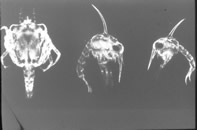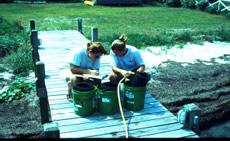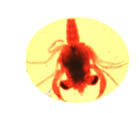Ongoing Blue
Crab Research by Dr. David Eggleston's Group
Recruitment
Water Quality Stock
Assessment Stock enhancement and Pond Grow-out
Outreach Current
Publications
Ecological
Studies -- Recruitment Dynamics
Current and recent research has focused on blue crab recruitment
in Pamlico Sound, NC. Recruitment can be defined simply as movement
of crabs into an area. This research has looked at movement of blue
crabs in two different life stages, the megalopal and juvenile stages
(see life history). Primary
dispersal, or blue crab movement and settlement at
the megalopal stage, explains the occurrence of blue crabs at areas
near Oregon and Hatteras Inlets (map).
Blue crabs are predicted to get to other portions of Pamlico Sound,
specifically sites on the western side (map),
through secondary dispersal. Secondary dispersal is transport of juvenile
crabs by primarily wind-driven water currents.

top
Ecological Studies -- Water
Quality
Research in this area has focused on the effects of low oxygen levels
on blue crab behavior. Studies have looked at the effects of both hypoxia
(low oxygen) and anoxia (no oxygen) effects blue crabs. Field and laboratory
work has looked how these conditions effect blue crab movement and feeding
behavior.
top
Fisheries Stock Assessment Research
Fishery-dependent and -independent data are being analyzed statistically to determinethe status of the blue crab population in North Carolina. This is useful in determining how
the population is responding to intenst fishing pressures. One general
goal of this research is to help regulation agencies determine how to
make the blue crab fishery a sustainable industry, allowing crabbers
to make a living while preserving populations for future generations.
For more information, and trends in the fishery, please see the fishery
page.

Megalopa (left), and two stages of Zoea
top
Stock Enhancement and Pond Grow-Out
We are currently testing the feasibility of rearing blue crabs using hatchery technology and stocking these crabs in underutilized nursery habitats to enhance the recruitment limited population of blue crabs in North Carolina. We are also assessing the feasibility of fresh water pond grow-out of hatchery-reared blue crabs to augment the soft-shell industry in North Carolina. This research is conducted in collaboration with colleagues at the University of Maryland Center of Marine Biotechnology, Smithsonian environmental research center, the Virginia Institute of Marine Science, and the University of Southern Mississippi.
top
Education
and Outreach
We have given high school students
from coastal North Carolina the opportunity to get involved in our research.
Every day from August 1 through October 31, the students collect megalopae
samples from artificial collectors that are posted at Manns Harbor,
Engelhard, Oregon Inlet and Hatteras Inlet. In addition, a fifth grade
class along with their parents and teacher are collecting samples at
Wrightsville Beach. The data generated from these samples is being used
to quantify daily megalopal settlement, in an effort to make predictions
about North Carolina's blue crab breeding stock, and determine the importance
of physical factors such as wind direction and speed in megalopal transport
into estuaries. The students get a unique opportunity to be involved
in research in their community, interact with scientists, and get solid
scientific field experience. The data they gather is a valuable tool,
and is being used as a Master's Thesis for Grant Parkins, one of Dr.
Eggleston's students.

High school students collecting samples
In addition, lessons
have been developed designed to allow high school teachers to incorporate
blue crab and estuarine ecology into their regular science curriculum.
The lessons adhere with the North Carolina Science Standard Course of
Study, and could be useful to a number of differenty types of science
classes. The effectiveness of these lessons is being tested with a pretest/posttest
method to determine is student understanding is improved through their
participation.
In terms of education, the research
group has constructed a
blue crab home page and, in conjunction with UNC-TV, released a
video describing the research and outreach efforts of this project.
top





